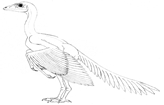 |
|
Why do scientists study fossils?
Scientists use fossils to know how prehistoric organisms might have looked. Sometimes the structure of an organism is preserved, as well as different growth stages from embryo to adult. Such remains allow scientists to determine how closely related fossil organisms are to one another and to living organisms. The fossil record contains evidence of how life has changed and evolved throughout the earth’s history.
| Type of fossil | An example |
| 1.An entire organism | The mammoth elephant preserved in snow. |
| 2.The hard parts | The fossils of bones , teeth & shells. |
| 3. Petrification is preservation of plants by the crystallization of minerals inside cells. mineral-rich fluids enter the plant’s cells and crystallize, making the cells appear to have turned to stone (petrified). | The petrified forests in Mokattam plateau. |
| 4. Moulds(sediments that fill the cavity in the mollusk , the mould hardens showing the internal details of the organism) | Mollusks buried in sediments. |
| 5. Casts ( marks made by organisms that fall in a soft surface) |  Leaves fallen on a muddy surface. Leaves fallen on a muddy surface.
|
| 6. Prints (deep marks) | Foot prints Ex . Dinosaur prints |



 Examples of Intermediate link
Examples of Intermediate link
|
|


Give Reasons:
1. The fossil of archaeopteryx is an evidence for evolution.
because the archaeopteryx shares features with reptiles such as the jaws, sharp teeth, a long bony tail and claws on its wingtips. Also it has features like birds such as the feathery wings for flying.
2. Lung fish is considered as link between fish & amphibians.
This fish breathes through its gills like all fish however it also has lungs like amphibians to use it in breathing in case of low oxygen water environment such as swamps.
3. The Black Biston betularia butterflies spread with the industrial evolution.
Natural selection allowed these type of butterflies to survive because they're not easily spotted by predators when they rest on tree trunks blackened by soot.

Give Reasons for:
The appendix is considered vestigial organ in humans.
In herbivores (plant eaters), the appendix helps digest the cellulose in plants . It's believed that humans had ancestors who fed on plants & the appendix helped in digestion , with evolution humans nowadays , don't have a function for the appendix(the appendix is still present but very small).The human retains evidence of structures that are probably relics from previous mammalian ancestors. This feature has little apparent function in modern humans. Relic featuressuch as the appendix are called vestigial organs. The appendix is a narrow tube attached to the large intestine. In some plant-eating mammals, the appendix is a functioning organ that helps to digest plant cellulose. In humans, however, the organ lacks this purpose and is reduced in size. Herbivores have large appendices while carnivores lack them.

a. At their early stage, the embryos of many animals look similar.
b. Embryos of many vertebrates have gills first.
c. These gills disappear later.
 d. The heart starts with one auricle and one ventricle then develop into 4 chambers.
d. The heart starts with one auricle and one ventricle then develop into 4 chambers.
 | |||
 |
 All the limbs of vertebrates have five digits. These limbs are modified to suit movement in their environment
All the limbs of vertebrates have five digits. These limbs are modified to suit movement in their environment
·
|
· Hooves for running
· Peddles for swimming
·  Hoofed animals have only one digit .
Hoofed animals have only one digit .

| Class | Nitrogenous wastes | Figures | Reasons |
| Fish & Tadpole | Ammonia |  
| Ammonia is soluble in water and passes out through the gills. |
| Reptiles & Birds | Uric acid |  
| Uric acid is insoluble in water , it is excreted with small amount of water. |
| Amphibians & Mammals | Urea |  
| Urea is soluble in water , it is excreted with large amounts of water in the urine. |
The Modern Synthetic theory corrects the defects in Darwin's theory .